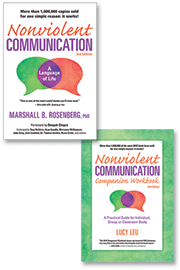Compassion as a "Felt-Sense"
... continued
This can happen immediately or gradually over time with enough repetition. However, it's not always immediately apparent which words will have this effect.
For example – Andy works as a developer for a web-based company. Here's a morning email sent by Andy, to a group of co-workers. He believes that one or more of them is responsible for launching updates to the web site that have caused the site to break.
"The site is looking like a complete cluster-f**k this morning… Did you guys not check it before you went home last night? We need to get some quality control going on people!"
So what will be the effect of this email on the relationship between Andy and the recipients of the email? Put yourself in the place of one of the recipients…how do Andy's words land with you? What thoughts come into your head? Any feelings you notice springing up?
Context is key. So is this email...
- an example of the jokey, casual style used between a group of co-workers at a start-up who work and play together through most of their waking hours?
or
- the words of someone who keeps his job because of his technical brilliance, at the cost of great stress, lost productivity and even staff turnover amongst his co-workers?
or
- the latest in a history of inflammatory messages sent between two warring departments – a morale and productivity sapping situation that no one seems to know how to fix?
I've been a co-worker or consultant in all three of these situations, and I know that Andy's email is quite realistic in each.
So, there's not just one essential way to communicate. I can't honestly say that in all cases if you write what Andy wrote you will contribute to problems happening. Often you will though, so what to do?
I find the acronym W.A.I.T very useful in my life, and I am very grateful for it. Here are a couple of versions of it that I use:
What
Am
I
Thinking?
and
Why
Am
I
Talking?
Both of these remind us of what we surely all know and have known since childhood – that sometimes it's worth WAITing for a moment before speaking (or hitting the send button).
I have co-workers today, as I've had for years, who will cut me a lot of slack if I say something they don't like. We have built up a lot of trust – we trust that we like, value and care about each other, and that we are doing the best we can come up with in any given moment.
So if I say something that lands sharply they'll tell me quickly, and they'll stay open and curious to figure out what is troubling me, and whether it's anything to do with them. With these people I might not WAIT very often, I mean I'll just speak or hit "Send" knowing that even if I even hit a disharmonious note with them, we'll easily work through it.
With co-workers, or anyone else, where I don't have that same level of trust and ease, I certainly employ the WAIT strategy.
"What Am I Thinking?" is a useful way to notice if my thoughts include thoughts of the finger-pointing variety. The questions also gives me chance to stop and check my ideas, opinions, suggestions, strategies etc. relevant to the situation at hand.
"Why Am I Talking?" (or writing) means to me
- "What outcome do I want from this exchange?" (Considering both immediate and longer-term outcomes can be helpful)
And since I want my words to achieve this outcome, I also ask the following questions:
- "Are the words I'm about to say or send going to achieve my desired outcome?"
- "What impact will my words have on those receiving them?"
So, imagine Andy pausing, WAITing in each of the three scenarios above…
What am I thinking? I'm thinking the site is messed up and that we need to fix it before we start getting too many customer emails and complaints. And I'm thinking I want to work together with the one or more of the group of co-workers I'm about to email.
Why am I talking?
- "What outcome do I want from this exchange?"
I want my friends to jump on this with me, and quickly. No long-term outcome intended here.
- "Are the words I'm about to say or send going to achieve my desired outcome?"
Yes, my words will prompt one or more of them to jump into action like we always do. Knowing Jim he'll reply first and we'll have it fixed before even eating breakfast.
- "What impact will my words have on those receiving them?"
They'll probably laugh or smile because it's an in-joke with us about needing quality control, because we all actually trust each other so much to be attentive to the quality of what we do.
So, the wait is over in this scenario. Andy has here given himself clearance to hit "send."
What am I thinking? I'm thinking that I work with people who are stupid and incompetent, and that I'm tired of being the only one who actually pays attention and keeps on top of what we're meant to be doing here. I'm thinking I'm once again going to have to fix something that was broken by others.
Why am I talking?
- "What outcome do I want from this exchange?"
I want them to realize they screwed up again, and longer term, hopefully soon, I want them to get their act together and stop messing stuff up.
- "Are the words I'm about to say or send going to achieve my desired outcome?"
I doubt it, based on past experience.
- "What impact will my words have on those receiving them?"
They'll complain that I'm being too hard on them. They won't focus on actually changing how they do things, they'll just focus on how I should "talk nicely" or something like that.
(The Andy in this scenario is quite likely to run on here to thoughts like "…but it's there fault. I do my job, why can't they do theirs?" etc. These thoughts are, for me, just more answers to the earlier question "What Am I Thinking?")
So, in this case the wait is not over. Andy's answers to these questions are telling him that he has no confidence that the message he's about to send is actually going to achieve his desired outcome. He's a man who's famous for "being smart" – but by his own standards of "smartness," he surely cannot justify taking an action that he's nearly certain will fail to achieve his desired goal.
Whether Andy likes it or not, it's a feature of working with humans that how you deliver your message affects whether you're successful in what you're trying to achieve.
So what does Andy do now? Well, in some cases as soon as you realize that what you're saying, or about to say or write, is not going to achieve your goal, it will quickly becomes clear what you can say instead that will be more effective.
There are some simple guidelines for doing that, but that's a subject for another article, or you can take some training at the Communication Dojo on giving and receiving feedback – to find out more effective ways of turning your thinking into communication that actually achieves what you're aiming for.
Let's not forget about the warring departments in scenario 3…
What am I thinking? Er…I'm thinking this is typical of them. Business as usual. I'm thinking that it's crazy that no one does anything about this, but that's just how it goes around here.
Why am I talking?
- "What outcome do I want from this exchange?"
Well, I want them to know that we know what they're up to – shoddy work, cutting corners, lack of attention to detail, no concern about the company's reputation, poor leadership and so much more. Long term, or as soon as possible, I guess I'd like them to start making improvements. It would make my working life a lot better.
- "Are the words I'm about to say or send going to achieve my desired outcome?"
Very unlikely, they'll just turn it all around like they always do.
- "What impact will my words have on those receiving them?"
One of them will fire something back that will really escalate things and then a bunch of people on both sides will jump in on the flame game. So, strictly speaking my words here will have an impact on them that makes them want to fight, makes them angry, I suppose.
Once again, the Andy in this scenario is seeing that the words he's about to send will not achieve what he most wants to achieve, based on past experience. This can be quite an illuminating moment – when we realize we're doing something out of habit, or anger, or some other unexamined motivation – but that what we're doing is not even in our own best interests.
There are many other things Andy can do with this realization, but hitting "Send" is not what I would choose here.
See more a CommunicationDojo.com.
(Reprinted with permission from CommunicationDojo.com)
Newt Bailey - Mediator, Facilitator, Coach and Communication Trainer. Founder and Lead Trainer of Communication Dojo.
www.newtbailey.com
www.communicationdojo.com
Keep learning these vital
communication skills with these books and training
resources:
This Month's Specials:
- Connecting Across Differences 2nd Ed. Book Save 65%
or eBook Save 90% off list price through May 31, 2016
- NVC Essentials Book Package or eBook Package Save 50% off list price through May 31, 2016
Every Day Book
Package Specials:
- NVC Marshall Rosenberg Book Package and eBook Package - Save 45%-55% on this book package every day from PuddleDancer Press
- NVC Reference Library Package and eBook Package - Save 55%-60% on this book package every day from PuddleDancer Press
- Save at least 30%-55% off all other titles every day.
.








